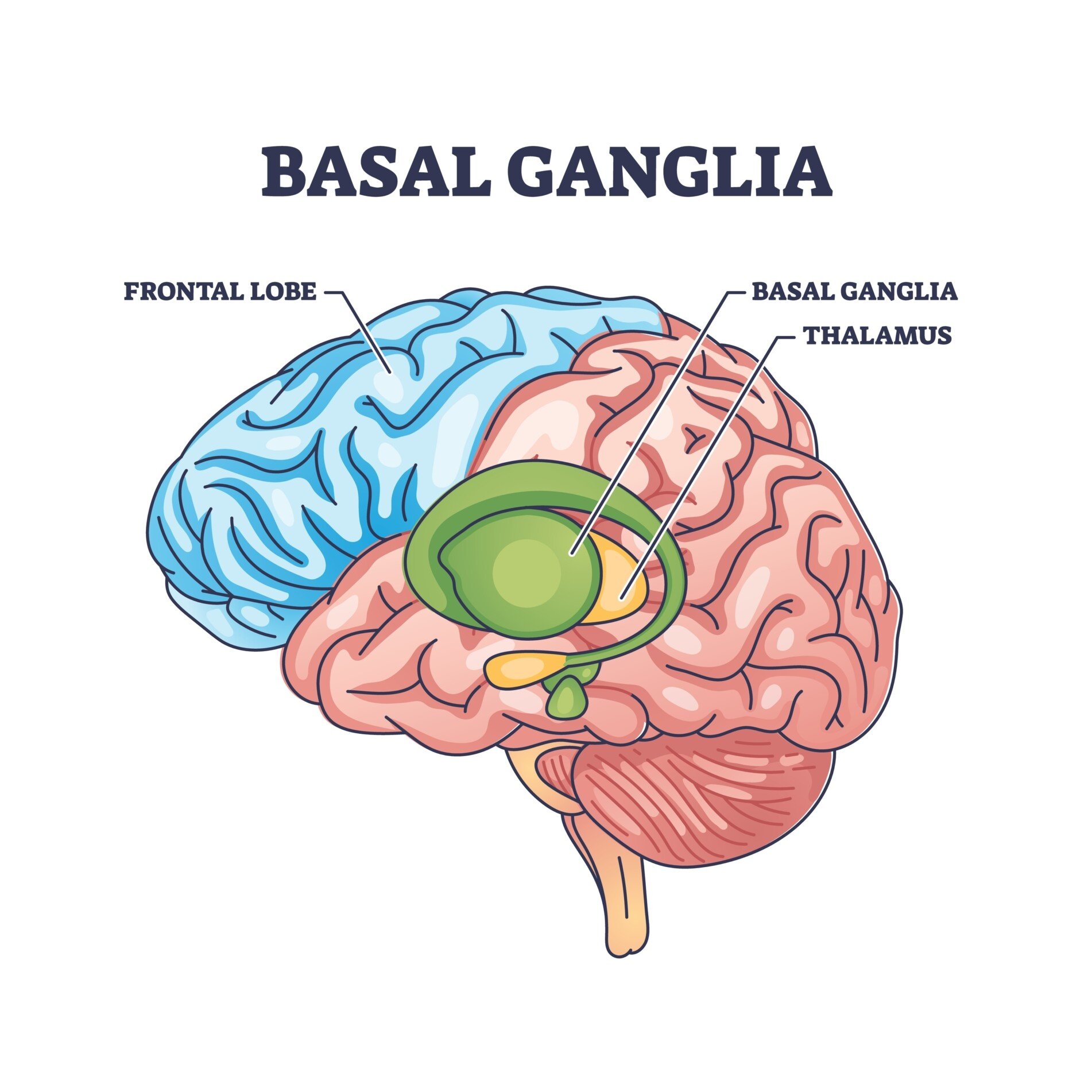The basal ganglia are a group of structures deep within the brain, located at the base of the forebrain.
Despite the name, they aren’t “ganglia” in the peripheral sense but rather clusters of neurons (nuclei) inside the central nervous system.
These structures work together to help coordinate our movements, habits, emotions, and motivations.

In simple terms, the basal ganglia function like a control hub that links different parts of the brain to ensure our actions are smooth and appropriate.
Think of the basal ganglia as a kind of traffic controller for movement signals. They help decide which movement “go” signals to allow and which impulses to hold back, much like traffic lights allowing cars through an intersection at the right time.
This means they filter out unwanted movements and let desired actions proceed, preventing random jerks or tics.
By fine-tuning these signals, the basal ganglia help you start actions when you intend to and stop actions when they’re not needed, keeping your behavior well-regulated.
Where Are the Basal Ganglia Located?
The basal ganglia are tucked deep inside the brain, beneath the wrinkled cerebral cortex. They sit near the center of the brain, surrounding a structure called the thalamus.
If you could look at a brain slice, you’d find the basal ganglia on each side of the brain – one set in the left hemisphere and one in the right.
In fact, these structures are symmetrical, meaning the left and right basal ganglia are almost mirror images of each other.
This deep, central location makes them well-positioned to receive signals from the cerebral cortex above and communicate with other areas like the thalamus and brainstem.
While you can’t see the basal ganglia from the brain’s surface, they are centrally placed, sometimes described as forming a ring or collar around the thalamus.
Their position at the base of the forebrain (and top of the midbrain) allows them to act as a middleman between higher brain regions and lower brain centers.
In summary, the basal ganglia lie under the cortex, near the middle of your brain, with matching structures on both sides for integrated control of your left and right body movements.
Key Parts of the Basal Ganglia
The basal ganglia are made up of several key parts, each with specific roles. These include two larger nuclei and a few smaller but important structures.
The main components of the basal ganglia are:
Caudate nucleus and Putamen
These two form the striatum, which is the primary input area of the basal ganglia. The striatum receives signals from many areas of the cortex.
The caudate (a curved, tail-like nucleus) and the putamen work together to help initiate and regulate movements. They also contribute to learning, memory, and routine behaviors.
Globus pallidus
This sits next to the putamen and has two segments (internal and external). The globus pallidus is an output region – it sends inhibitory (restraining) signals to other parts of the brain. By doing so, it helps control the intensity and coordination of movements.
Subthalamic nucleus
A small lens-shaped nucleus below the thalamus. It helps modulate the output of the basal ganglia.
The subthalamic nucleus is crucial for preventing unwanted movements – if it’s damaged, people can develop jerky, flinging movements (as seen in a condition called hemiballismus).
Substantia nigra
A dark-colored region in the midbrain (not in the forebrain, but functionally part of the basal ganglia). It has two parts, one of which produces the neurotransmitter dopamine.
The substantia nigra acts as a critical connection providing dopamine to the striatum, which the basal ganglia need for normal function. When cells in this area die, it leads to the movement problems seen in Parkinson’s disease.
(Grouping terms: You may hear “striatum” used to mean the caudate and putamen together, or “lentiform (lenticular) nucleus” to mean the putamen plus globus pallidus because of their lens-like combined shape.)
All these parts are heavily interconnected. They form circuits that loop information from the cortex (thinking part of the brain) through the basal ganglia and back up to the cortex via the thalamus.
Each component plays a part in processing and routing these signals so that we get coordinated outcomes.
What Do the Basal Ganglia Do?
The basal ganglia have several important functions that influence our movements, habits, and even emotions. Key roles of the basal ganglia include:
- Initiating and stopping movement: They help start desired movements and halt unwanted movements. For example, when you decide to raise your hand, basal ganglia circuits help launch that action – and they also help keep your arm still when you’re not intending to move.
- Learning habits and routines: The basal ganglia are central to procedural learning – learning by doing. Repeated actions become more automatic thanks to these structures.
- Reward and motivation: Dopamine released in the basal ganglia (notably in pathways from the substantia nigra and related areas) reinforces behaviors that lead to rewards. This helps motivate us – for instance, getting pleasure from scoring a goal or finishing a task encourages us to repeat those behaviors.
- Emotional regulation: The basal ganglia connect with the limbic system (the brain’s emotional centers). They assist in regulating emotional responses and drive-related behaviors. This means they have a hand in how we process feelings and may influence mood and impulse control.
In essence, the basal ganglia act as a filter and fine-tuning system for the brain. They take in instructions from the cortex and other areas, then select the appropriate action and suppress others.
By doing so, these structures ensure our movements are smooth and purposeful, and our behaviors align with our goals and context. Without this filtering, our actions might be too erratic or difficult to control.
Basal Ganglia and Motor Control
The basal ganglia play a crucial role in movement by balancing “Go” and “Stop” signals through two main pathways. The direct pathway acts like an accelerator, initiating movement, while the indirect pathway functions like a brake, inhibiting actions. Both are essential for smooth, controlled motion.
This system helps us start desired actions and stop inappropriate ones. For example, if you feel the urge to check your phone in class, the indirect pathway can suppress that impulse.
Later, when it’s appropriate, the direct pathway allows the movement. This balance enables self-control and coordinated motion. Without it, movements could become jerky or impulsive.
Basal Ganglia and Reward, Motivation, and Learning
Beyond motor control, the basal ganglia are central to motivation, learning, and habit formation. Dopamine, released by neurons in the substantia nigra, signals rewarding outcomes, reinforcing behaviors worth repeating.
This reward system supports habit learning—transforming deliberate actions (like learning to drive or play an instrument) into automatic routines. Over time, repeated behaviors become ingrained as habits.
The basal ganglia also support goal-directed behavior, working with the frontal cortex to help us choose actions that lead to desired outcomes.
They reinforce rewarding behaviors and help us avoid unproductive or punished ones, shaping both motivation and daily habits.
Disorders Linked to Basal Ganglia Dysfunction
Because the basal ganglia are so central to movement and behavior control, it’s not surprising that problems in this circuit can lead to a range of disorders.
When the basal ganglia don’t work properly, people can experience difficulties with either too little control or too much unwanted activity.
A few notable examples include:
Parkinson’s disease
A movement disorder where cells in the substantia nigra die off, leading to a lack of dopamine. Without enough dopamine feeding the basal ganglia, patients have a hard time initiating movements.
They may move slowly, have muscle stiffness, and often show tremors. It’s as if the “brakes” are stuck on, making it difficult to get movements going.
Huntington’s disease
A genetic disorder that causes degeneration of neurons in the striatum (part of the basal ganglia). This leads to uncontrolled, jerky movements and twitches (often called chorea).
In Huntington’s, the usual inhibitory control of the basal ganglia is weakened – the “brakes” fail, resulting in excess movements that the person can’t control well.
Obsessive-Compulsive Disorder (OCD)
Though OCD is a psychiatric condition, it has been linked to basal ganglia loops that malfunction. People with OCD experience intrusive thoughts and repetitive behaviors (compulsions).
One theory is that basal ganglia circuits get “stuck” in certain patterns, making it hard to break the cycle of repeated checking or cleaning because the brain’s “filter” isn’t gating those behaviors properly.
Attention-Deficit Hyperactivity Disorder (ADHD)
This condition has been associated with differences in basal ganglia activity and dopamine levels. A poorly regulated basal ganglia in ADHD might contribute to difficulty in sustaining attention and controlling impulses.
In effect, the brain’s ability to filter out distractions or unwanted impulses is compromised, leading to inattention or hyperactive behavior.
Tourette’s syndrome
A neurological disorder characterized by tics (sudden, involuntary movements or sounds). Tourette’s is believed to involve irregularities in basal ganglia circuits that fail to suppress these random signals.
As a result, individuals make movements or sounds that they don’t intend to – reflecting a struggle in the basal ganglia’s normal role of inhibiting unwanted actions.
Why Are the Basal Ganglia Important in Psychology?
The basal ganglia are key to understanding how brain biology shapes behavior. They link neural activity to functions like decision-making, habit formation, self-control, and emotion—highlighting how physical brain structures influence what we do and who we are.
This is especially important in neuropsychology and mental health. Difficulties with impulse control, learning, or motivation often involve dysfunction in basal ganglia circuits.
As a central hub connecting motivation, action, and reward, they help explain why certain experiences shape our behavior—and why damage to these areas can alter movement or personality.
In short, the basal ganglia show that behavior has biological roots. They help bridge psychology and neuroscience, offering insight into conditions like Parkinson’s and OCD, and illustrating how brain circuits shape everyday habits and choices.

